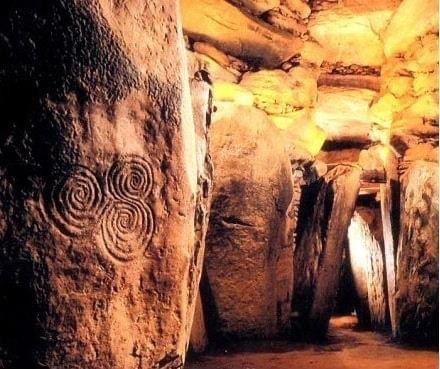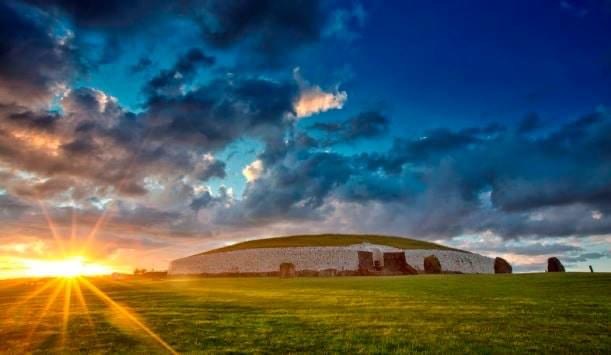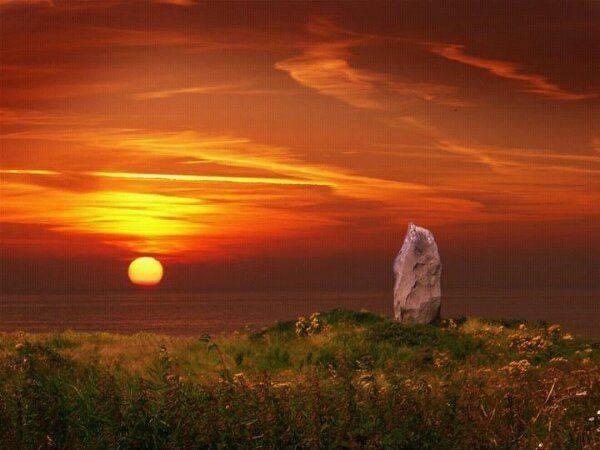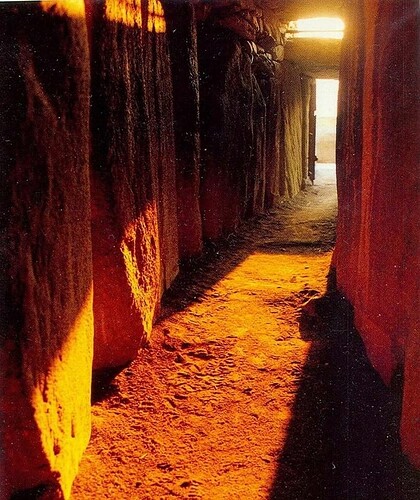If anyone is interested, this is from a Facebook group on Irish mythology. A day late
The Winter Solstice in Bru na Boinne.
This year’s shortest day of the year is on Tuesday, December 21, which will also mark the longest night of the year. Several rare events make this years’ winter solstice particularly special as the upcoming December full moon, named the Cold Moon, will be visible in the night sky along with the Ursid meteor shower. The name of the moon originates from the Native Americans, who marked December’s full moon as the beginning of the coldest part of the year.
Another rare occurrence, the Ursid meteor shower will be visible in the mid-Northern Hemisphere and at the peak there will be about 11 meteors per hour just before dawn. The shower gets its name because its meteors appear to emanate from Ursa Minor, also known as the Little Dipper. Unfortunately, due to the brightness of the full moon, the meteors might be hard to spot. These combined events make this years’ solstice particularly symbolic and would have had deep meaning for the ancient cultures who scanned the heavens.
Every year, the winter solstice marks the turn of the calendar as autumn ends and the winter begins. From an astronomical standpoint, the winter solstice means that the two opposite points in the sky to which the Earth’s axis of rotation points change very slowly. Over the course of about 26,000 years, a complete circle is created. From a cultural standpoint, the winter solstice was used to mark a number of events, including mating season for animals, the sowing of crops and monitoring winter reserves of food.
In Ireland, after Samhain, the Winter Solstice is the next important time in the Irish calendar year, for a number of reasons. During the harsh winter months the veil suspended between life and death is particularly thin and it is believed that contact can be made with the inhabitants of the otherworld. During these shrouded months, known as the ‘famine times,’ starvation was an ever present concern and certain steps were taken to ensure an abundance of food for the coming year.
After herding their cattle and sheep down from the higher slopes and guiding them through the pathway between large bonfires in a cleansing ritual, the great slaughter took place. This ensured plenty of meat, a stockpile of hides and wool plus a saving on winter feed for the other animals. Oats, wheat and barley would have already been be cut and stored in the granaries and the wines and beers which had been fermenting since earlier in the year, were also now ready for consumption and thus life would go on.
Gatherings, led by the Master, and celebrated in dance and song, would take place in the sacred oak groves. There, in the soft, filtered moonlight thanks and praise would be offered to the deities for their bounty. At evenings end and just before dawn, an important ceremony would be held at the Neolithic passage grave sited in the Boyne Valley.
Newgrange, the ancient passage tomb, high on the eastern bank in the river valley was built long before Stonehenge and the pyramids in Egypt and erected in such a way that on the solstices, the sun’s rays penetrate the light box above the entrance and fill the passageway and inner chamber with light. The ancients believed that the souls of the departed, represented by their ashes which had been placed in the innermost chamber, in stone urns, throughout the preceding year, were then taken by the retreating rays and transported to the afterlife.
The Solstice
From the stone of Fal on Tara high,
'cross the river that flows deep and slow,
the ancients all gather at this holy place
to catch the bright morning’s warm glow.
In robes of pure white, they walk the ground
and wait for the rising sun. In the heart of the
mound, old souls can be found;
heaven bound, they now become one.
The Master appears, an unearthly sight,
and raises his arms to the sky. The people
bow down, and kneel on the ground,
then chant with a joyful cry.
The rays creep across the hills and the glen,
and strike the box over the door.
They follow along to the chamber, and then,
the love there enshrined, proudly soars.
It has always been done in this very way,
and for eons will last evermore.
Their spirits will rise and fly every day,
and watch over our true heart’s core.
The Mound
The complex of Newgrange was originally built between 3200 and 3100 BC. According to carbon-14 dates, it is about five hundred years older than the current form of Stonehenge, and the Great Pyramid of Giza in Egypt, as well as predating the Mycenaean culture of ancient Greece. Geological analysis indicates that the thousands of stones that make up the cairn, which together would have weighed about 200,000 tons, came from the nearby river Boyne. Most of the 547 slabs that make up the inner passage and chambers and the outer kerbstones are greywacke and may have been brought from sites about 5 km away, and from the rocky beach at Clogherhead, County Louth, about 20 km to the north-east.
The facade and entrance were built with white quartz cobblestones from the Wicklow Mountains, about 50 km to the south; dark rounded granodiorite cobbles from the Mourne Mountains in Co. Down, about 50 km to the north; dark gabbro cobbles from the Cooley Mountains; and banded siltstone from the shores of Carlingford Lough. It is believed that the stones may have been transported to Newgrange by sea and up the River Boyne by fastening them to the underside of boats at low tide. None of the structural slabs were quarried, as they show signs of having been naturally weathered, so they must have been collected and then transported uphill to the Newgrange site. The granite basins found inside the chambers also came from the Mournes.
The astronomical mysteries of Newgrange run deeper and in 1958, in his book about primitive mythology, author Joseph Campbell recounted a folk tale from the Boyne Valley in which a local had told him that the light of the Morning Star, Venus, shone into the chamber of Newgrange at dawn on one day every eight years and cast a beam upon a stone on the floor of the chamber containing two worn sockets. This might seem like an incredible suggestion, except for the fact that it is astronomically accurate. Venus follows an eight-year cycle and on one year out of every eight, it rises in the pre-dawn sky of winter solstice and its light would be able to be seen from within the chamber.
During the medieval period, Newgrange and the wider Brú na Bóinne Neolithic complex gained various attributes in local folklore, which was often connected to figures from the wider Irish mythology. The monuments of the Brú were thought of by some as being the abode of the supernatural Tuatha De Danann, whilst others considered them to be the burial mounds of the ancient kings of Tara. Amongst those who believed the folk-tales relating the Brú to the Tuatha De Danann, it was commonly thought that they were the abode of the most powerful of the Tuatha, particularly The Dagda, his wife Boann and his son, Oengus.
According to the 11th century Book of Lecan, the Dagda had built the Brú for himself and his three sons, whilst the 12th century Book of Leinster describes how Oengus tricked his father into giving him the Brú for all eternity. Another text, The Pursuit of Diarmaid and Grainne also implies that Oengus owned the Brú, when he declared how he took his friend Diarmaid to it. Sometime after 1142 it became part of outlying farmland owned by monks of the Cistercian Abbey of Mellifont. These farms were referred to as ‘granges’. Newgrange is not mentioned in any of the early charters of the 12th and 13th centuries, but a decree, granted by Edward III in 1348 includes a Nova Grangia among the demesne lands of the abbey.
On 23 July 1539, following the Dissolution of the Monasteries by Henry VIII, Mellifont Abbey and its demesnes became the fortified mansion of an English soldier of fortune Edward Moore, ancestor of the Earls of Drogheda. On 14 August 1699, Alice Moore, Countess Dowager of Drogheda, leased the demesne of Newgrange to a Williamite settler Charles Campbell for 99 years. Today, Newgrange is owned and maintained by The Office of Public Works and is a World Heritage site visited by thousands of people from all over the world, every year.
Many thanks to https://www.newgrange.com/ for their valuable information which made this article so much better.
Photos courtesy of Wikimedia.
© John A. Brennan 2021. All Rights Reserved.



